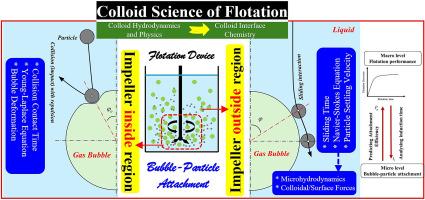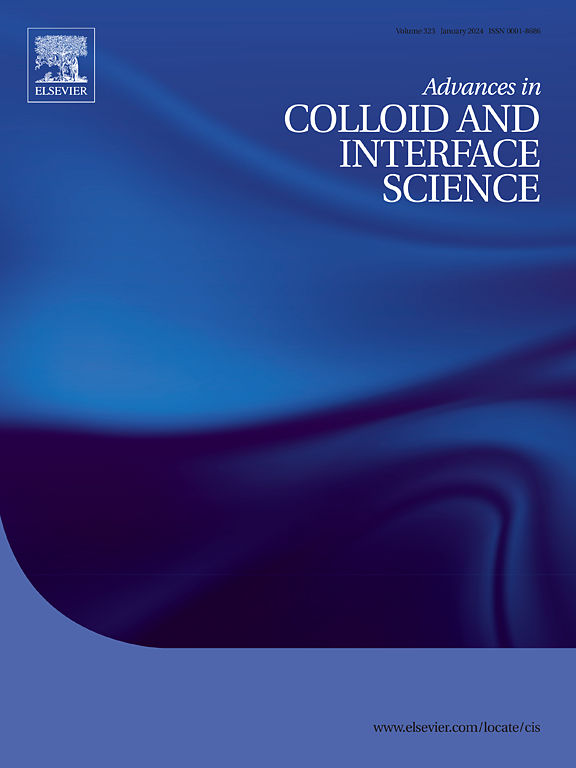气泡-颗粒接触时间的改进模型:浮选附着效率预测的综合综述
IF 19.3
1区 化学
Q1 CHEMISTRY, PHYSICAL
引用次数: 0
摘要
基于表面疏水性以及胶体和表面化学的许多其他方面,气泡-颗粒附着是浮选中的一个基本过程,对决定分离效率至关重要。这篇综述检查和改进了接触时间模型——包括碰撞、滑动和附着相互作用——以量化浮选系统中的附着效率。首先,我们探索了气泡-颗粒碰撞和附着过程中滑动相互作用的潜在胶体物理,强调了气泡表面颗粒的速度成分,包括水流和颗粒沉降。考虑到气含率和气泡表面迁移率的影响,对气泡表面附近水速度的近似模型进行了严格的评估。该综述还评估了滑动时间模型,讨论了它们在不同条件下预测附着效率的作用,如雷诺数、气泡表面迁移率、流动不对称、气体含率和惯性力的变化。讨论了这些模型的实验验证,强调了气泡表面的水流场和颗粒动力学如何影响附着过程的关键见解。虽然界面相互作用、微流体动力学和颗粒形态没有直接回顾,但本文认为它们是未来建模工作中需要考虑的关键因素。通过综合目前的模型并强调进一步发展的领域,本综述促进了对气泡-颗粒附着机制的理解,并通过改进的分析和计算方法为优化浮选效率提供了基础。本文章由计算机程序翻译,如有差异,请以英文原文为准。

Advancing models of bubble-particle contact times: A comprehensive review of flotation attachment efficiency prediction
Bubble-particle attachment is a fundamental process in flotation, critical for determining separation efficiency, based on surface hydrophobicity and many other aspects of colloid and surface chemistry. This review examines and refines models of contact time – encompassing collision, sliding, and attachment interactions - to quantify attachment efficiency in flotation systems. It begins by exploring the underlying colloidal physics of bubble-particle collision and sliding interactions during attachment, emphasising the velocity components of particles at bubble surfaces, including water flow and particle settling. Approximate models for water velocity near bubble surfaces are critically assessed, considering the influence of gas holdup and bubble surface mobility. The review also evaluates sliding time models, addressing their role in predicting attachment efficiency under varying conditions, such as changes in Reynolds number, bubble surface mobility, flow asymmetry, gas holdup, and inertial forces. Experimental validation of these models is discussed, highlighting key insights into how water flow fields at the bubble surface and particle dynamics influence attachment processes. While interfacial interactions, microhydrodynamics, and particle morphology are not directly reviewed, this paper identifies them as critical factors to consider in future modelling efforts. By synthesising current models and emphasising areas for further development, this review advances understanding of bubble-particle attachment mechanisms and provides a foundation for optimising flotation efficiency through improved analytical and computational approaches.
求助全文
通过发布文献求助,成功后即可免费获取论文全文。
去求助
来源期刊
CiteScore
28.50
自引率
2.60%
发文量
175
审稿时长
31 days
期刊介绍:
"Advances in Colloid and Interface Science" is an international journal that focuses on experimental and theoretical developments in interfacial and colloidal phenomena. The journal covers a wide range of disciplines including biology, chemistry, physics, and technology.
The journal accepts review articles on any topic within the scope of colloid and interface science. These articles should provide an in-depth analysis of the subject matter, offering a critical review of the current state of the field. The author's informed opinion on the topic should also be included. The manuscript should compare and contrast ideas found in the reviewed literature and address the limitations of these ideas.
Typically, the articles published in this journal are written by recognized experts in the field.

 求助内容:
求助内容: 应助结果提醒方式:
应助结果提醒方式:


